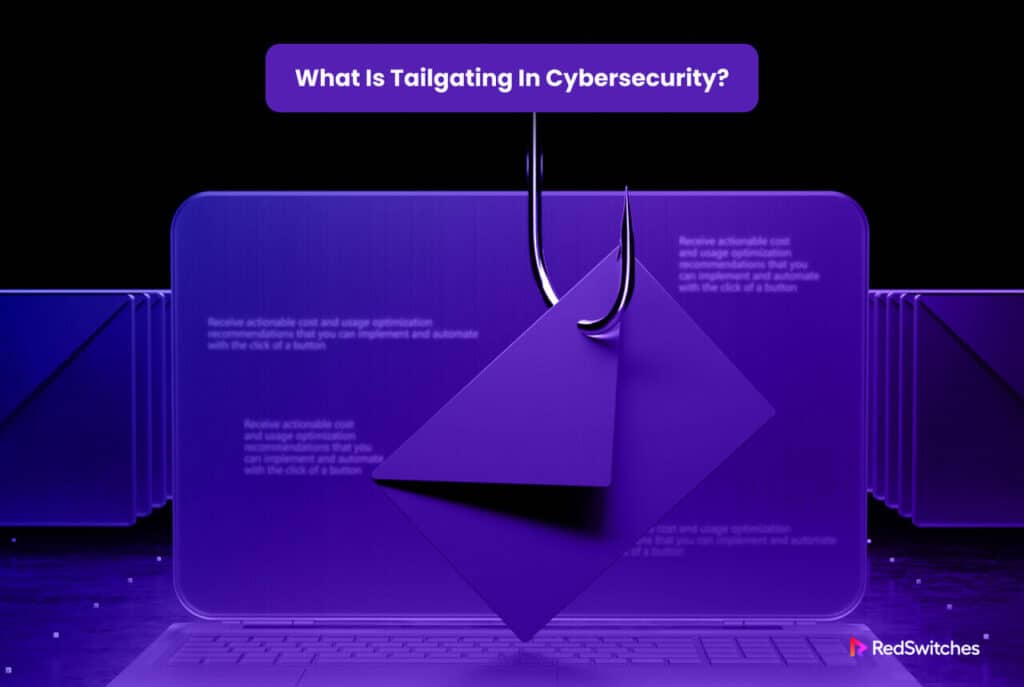Imagine a busy office complex where workers meticulously swipe their access cards to enter secured areas, ensuring they always follow the prescribed access privileges.
Now imagine a malevolent actor expertly sliding in behind the unwary employee as they approach the entrance to a high-security area. This seemingly innocent action gives the intruder access without authorization, possibly leading to security breaches.
This is how tailgating, a social engineering tactic, plays out and sets the stage for more damaging cybercrimes. At the very least, the attacker can access areas off-limits to unauthorized users and visitors. This can seriously jeopardize the security of your digital and physical assets.
This blog discusses what is tailgating in cyber security, the associated risks, and the mitigation strategies for tailgating incidents.
Table Of Contents
- What is Tailgating in Cyber Security?
- Risks and Impacts of Tailgating
- Prevention Measures for Reducing Tailgating Incidents
- Measure No 1: Employee Awareness and Training
- Measure No 2: Implementing Access Control Mechanisms
- Measure No 3: Visitor Management Protocols
- Measure No 4: Boost Physical Access Security
- Measure No 5: Employ Cutting-Edge Video Surveillance
- Measure No 6: Conduct Security Audits
- Measure No 7: Utilize Analytics to Detect Unauthorized Access
- Conclusion
- FAQ
What is Tailgating in Cyber Security?
In a tailgating social engineering attack, an unauthorized person compromises a company’s security system to gain physical access to the on-premises assets. These attacks are usually the staging points for subsequent attacks that result in data theft and compromised ICT infrastructure.
The act of an unauthorized person accompanying an authorized person into a company’s secure facilities is also known as piggybacking. Here the attacker takes advantage of human flaws and uses many attacks, including blackmail, identity theft, and physical security loopholes.
During such attacks, the attacker typically persuades or pressurizes an authorized person to grant them access to a protected physical area or digital space.
The Intentions Behind Tailgating
After discussing what is tailgating in Cyber Security, now we will focus on the intentions behind such attacks.
Tailgating attacks are committed for various reasons, all motivated by the attackers’ malicious objectives. However, all episodes have the common goal of entering restricted spaces without sufficient authorization. This unauthorized access is often used further to execute data breaches or the theft of tangible objects.
Other objectives include access and acquisition of trade secrets, research data, or intellectual property owned by the target organizations. Tailgating attacks are also used to obstruct operations, interfere with services, or gather intelligence.
Tailgating poses a danger to physical security since it is frequently used with social engineering strategies to trick unsuspecting people into granting access. Successful tailgating attacks can have serious, all-encompassing repercussions.
Tailgaters weaken the organization’s security posture by taking advantage of flaws in access control procedures, allowing for additional unauthorized access and potential breaches.
Such data breaches may result in the loss of confidential information, client information, or intellectual property, which may have a negative financial and legal impact on the organization. Tailgating attacks that result in the loss of tangible goods or interruptions to business operations can also result in significant financial losses, including the costs of replacing lost things, paying to fix the damage, and losing revenue while recovery attempts are underway.
Risks and Impacts of Tailgating
When discussing our core part, i.e., what is tailgating in cyber security, we discussed the definition of tailgating and the term piggybacking.
Like all social engineering attacks, tailgating impacts the viability and profitability of the target organization. That’s why understanding what is tailgating in cyber security is essential to hardening an organization’s security.
Let’s discuss some of the risks and impacts of tailgating incidents.
Data Breach and Unauthorized Access
Continuous occurrence of data breaches and illegal access are two critical risks of tailgating attacks. When an attacker illegally gains entry into a secure environment, they can bypass access controls to initiate an attack.
Such data breaches can have major financial repercussions for organizations as they can face legal consequences that may eventually damage their reputation.
Unauthorized access can also endanger vital infrastructure, causing services to be interrupted, valuable assets to be stolen, or operations to be sabotaged.
Compromised Physical Security
Tailgating attacks the integrity of the physical security measures that protect the organization’s assets. Attackers can sneak into protected environments by taking advantage of the trust placed in authorized employees, increasing the danger of additional attacks or unauthorized operations.
Unauthorized people entering sensitive spaces like data centers or research labs can inflict serious harm, steal expensive equipment, or participate in industrial espionage.
As a result, tailgating-related security breaches reduce consumer trust and confidence, which may result in a decline in business and partnerships. Additionally, organizations that experience tailgating instances may be found violating rigorous data protection laws.
Damage to Reputations and Compliance Violations
Successful tailgating attacks can drastically damage a company’s reputation. Security breaches resulting from tailgating incidents lower consumer confidence and trust, which could affect ongoing and future business and partnerships.
Additionally, tailgating incidents indicate potential violations of compliance requirements, especially in industries with strict data protection regulations. This often results in significant fines, legal troubles, and damage to business operations.
Prevention Measures for Reducing Tailgating Incidents
With so much at stake, the prevention of Tailgating has become a serious priority for businesses. We’ll now discuss the preventive measures required for controlling tailgating.
Measure No 1: Employee Awareness and Training
Every business should conduct an employee awareness training program to train their employees about the impact of tailgating attacks. These sessions should cover the following:
- Inform all staff members of the significance of not allowing outsiders to tailgate their admission.
- Provide frequent security awareness training to inform staff members of the dangers and potential repercussions of tailgating.
- Encourage workers to report any unusual conduct they see, especially if it involves tailgating or unauthorized access.
- Encourage using the “challenge and verify” principle whenever you doubt a person’s identity or access privileges.
Measure No 2: Implementing Access Control Mechanisms
Businesses should invest in access control mechanisms to protect physical access to critical areas. Additionally, you should consider upgrading the traditional keycard-based access control system to biometric scanners.
- Ensure the on-premises access control systems are regularly maintained and updated to avoid giving undue benefit to attackers.
- Use CCTV cameras with the access control system to monitor entrances and quickly identify tailgating attempts.
- To eliminate tailgating by design, consider utilizing mantrap or airlock devices that only permit one person to enter at a time.
Measure No 3: Visitor Management Protocols
Businesses should upgrade the traditional visitor reception rules and ensure the system records each visit for future analysis and investigations.
- Create a structured procedure for managing visitors that entails pre-registration and identity verification before allowing entry.
- Provide visitors with temporary IDs or visitor credentials that clearly state their level of access.
- Designate unique guest entry points, separate from the employee access points.
Measure No 4: Boost Physical Access Security
In most organizations today, you need a smart access card to enter the premises. The persistence of tailgating assaults demonstrates the inadequateness of this physical security mechanism.
We recommend augmenting this measure with the following:
- Set up an additional physical access security layer with reception rooms fully manned by professional security officers.
- Turnstiles, which only permit one person to enter at a time, is a substitute for controlling access to critical areas.
Measure No 5: Employ Cutting-Edge Video Surveillance
Even with a staffed front desk, it can be challenging to effectively monitor who enters and exits office buildings and various restricted areas. AI and video analytics are used in advanced video surveillance to assist organizations in enhancing real-time physical security monitoring. By combining video footage with facial scans of employees and contractors, these camera systems can determine who enters a building.
Measure No 6: Conduct Security Audits
Businesses should include the audit of the access logs in the extensive security audit.
This audit process can find workplace vulnerabilities through routine audits, which can also assist in indicating which areas need to be safeguarded before problems develop. Identifying entrances that present a larger risk for tailgating, such as a lobby entrance door, allows teams to take action at the appropriate places and protect high-traffic areas when considering what can be done to prevent tailgating.
Measure No 7: Utilize Analytics to Detect Unauthorized Access
Another strategy for reducing tailgating is data analysis from access control systems. This information can be used for cost-effective security decisions and to enhance workplace operations.
Thanks to these insights, businesses can proactively implement procedures and controls to reduce security risks and stop upcoming crises.
Conclusion
In this blog, we discussed what is tailgating in cyber security. We also mentioned the impact of this social engineering attack and how these incidents affect business operations and reputation. Finally, we presented several strategies to counter tailgating attacks and reduce the occurrence and impact of these attacks.
Dealing with social engineering attacks such as tailgating requires working with a knowledgeable partner such as RedSwitches. We understand the implications of social engineering attacks and regularly advise our clients on how to set up security to minimize tailgating attacks.
Get in touch to consult our security engineers for tips on strengthening your physical and digital security.
FAQ
1) What is tailgating in cyber security?
In cybersecurity, the act of following an authorized person through a protected access point and into a restricted area without permission is known as tailgating.
2) Is it possible to detect tailgating attacks in real time?
Since tailgating events depend on exploiting human behavior rather than technology flaws, they might be challenging to identify in real-time. However, the staff should detect suspicious activities and ensure everyone complies with proper security policies and proactive monitoring.
3) What should employees do if they believe someone is trying to tailgate?
Employees should immediately report any suspicious activity or attempted tailgating to the security team at their company. It is possible to prevent unauthorized access and enable a quick response to reduce potential hazards by promptly reporting such instances.
4) How frequently should businesses perform security audits to evaluate tailgating risks?
Depending on an organization’s risk profile and compliance needs, the frequency of security audits may change. Regular security audits, at least once or twice a year, aid in assessing tailgating threats and locating potential vulnerabilities.


